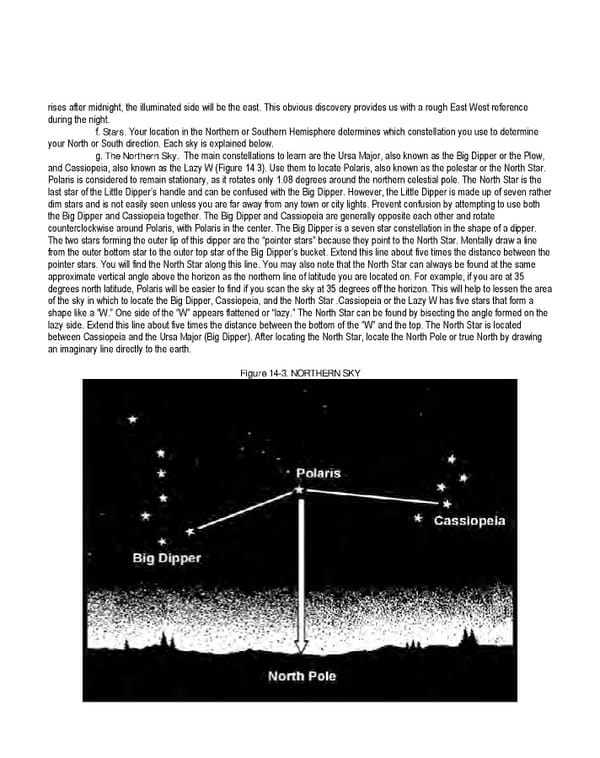rises after midnight, the illuminated side will be the east. This obvious discovery provides us with a rough East West reference during the night. f. Stars. Your location in the Northern or Southern Hemisphere determines which constellation you use to determine your North or South direction. Each sky is explained below. g. The Northern Sky. The main constellations to learn are the Ursa Major, also known as the Big Dipper or the Plow, and Cassiopeia, also known as the Lazy W (Figure 14 3). Use them to locate Polaris, also known as the polestar or the North Star. Polaris is considered to remain stationary, as it rotates only 1.08 degrees around the northern celestial pole. The North Star is the last star of the Little Dipper’s handle and can be confused with the Big Dipper. However, the Little Dipper is made up of seven rather dim stars and is not easily seen unless you are far away from any town or city lights. Prevent confusion by attempting to use both the Big Dipper and Cassiopeia together. The Big Dipper and Cassiopeia are generally opposite each other and rotate counterclockwise around Polaris, with Polaris in the center. The Big Dipper is a seven star constellation in the shape of a dipper. The two stars forming the outer lip of this dipper are the “pointer stars” because they point to the North Star. Mentally draw a line from the outer bottom star to the outer top star of the Big Dipper’s bucket. Extend this line about five times the distance between the pointer stars. You will find the North Star along this line. You may also note that the North Star can always be found at the same approximate vertical angle above the horizon as the northern line of latitude you are located on. For example, if you are at 35 degrees north latitude, Polaris will be easier to find if you scan the sky at 35 degrees off the horizon. This will help to lessen the area of the sky in which to locate the Big Dipper, Cassiopeia, and the North Star .Cassiopeia or the Lazy W has five stars that form a shape like a “W.” One side of the “W” appears flattened or “lazy.” The North Star can be found by bisecting the angle formed on the lazy side. Extend this line about five times the distance between the bottom of the “W” and the top. The North Star is located between Cassiopeia and the Ursa Major (Big Dipper). After locating the North Star, locate the North Pole or true North by drawing an imaginary line directly to the earth. Figure 14-3. NORTHERN SKY
 Ranger Handbook Page 253 Page 255
Ranger Handbook Page 253 Page 255